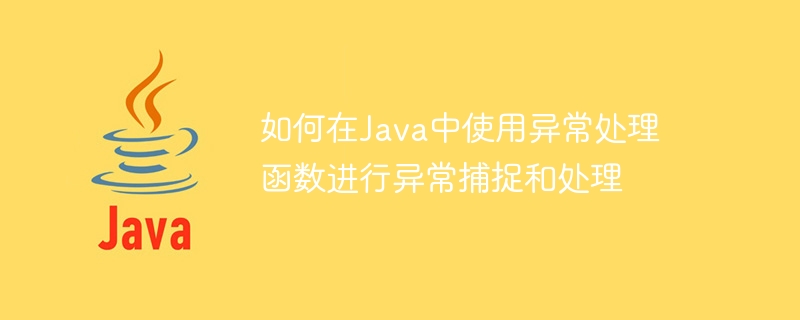Home >Java >javaTutorial >How to use exception handling functions in Java to catch and handle exceptions
How to use exception handling functions in Java to catch and handle exceptions
- 王林Original
- 2023-10-27 16:13:50773browse

How to use exception handling functions in Java to catch and handle exceptions
Exception handling is a crucial part when writing Java programs. When an error or exception occurs during program running, if it is not handled, it will cause the program to crash or produce unexpected results. In order to ensure the robustness and stability of the program, we need to use exception handling functions to catch and handle these exceptions.
Exception handling in Java is based on the concept of "catch and throw". When an exception occurs in a code block, the program will throw the exception, and the called method will catch and handle the exception. The syntactic structure of exception handling includes try-catch statements and finally blocks.
The try-catch statement is used to catch and handle exceptions. The part of the code block where exceptions may occur needs to be placed in the try code block, and the code that handles the exception needs to be placed in the catch code block. The catch code block will be specified to handle specific types of exceptions to ensure that the exceptions can be caught correctly.
The following is a simple sample code that shows how to use the try-catch statement for exception handling:
try {
// 可能会抛出异常的代码块
int a = 10 / 0;
} catch (ArithmeticException e) {
// 处理ArithmeticException异常的代码块
System.out.println("除法运算发生异常:" + e.getMessage());
} catch (Exception e) {
// 处理其他异常的代码块
System.out.println("发生了未知异常:" + e.getMessage());
}In the above code, we use the try code block to wrap the possible throws Exception code: 10/0. Since a denominator of 0 in a division operation will cause an ArithmeticException, we use catch(ArithmeticException e) to catch and handle this exception. If a divide-by-zero error occurs, the program executes the code in the catch block and prints out the error message.
In addition to the catch clause, you can also use the finally block to execute code that needs to be executed regardless of whether an exception occurs. The code in the finally block will be executed regardless of whether an exception occurs. This is useful for things like releasing resources, closing connections, etc.
The following is a sample code for exception handling with a finally block:
try {
// 可能会抛出异常的代码块
int[] arr = new int[5];
System.out.println(arr[10]);
} catch (ArrayIndexOutOfBoundsException e) {
// 处理ArrayIndexOutOfBoundsException异常的代码块
System.out.println("数组索引越界:" + e.getMessage());
} finally {
// 无论是否发生异常都会执行的代码块
System.out.println("finally块中的代码");
}In the above code, we deliberately accessed the out-of-bounds index in the array arr and threw it in the try code block An ArrayIndexOutOfBoundsException exception occurred. The catch code block will catch this exception and print out the error message. The finally code block will be executed regardless of whether an exception occurs, and a message will be output.
In addition to the try-catch statement, Java also provides the throws keyword to throw exceptions to the caller of the method for processing at the upper level. When a method may throw multiple exceptions, you can specify these exceptions in the method declaration using the throws keyword.
The following is a sample code using the throws keyword:
public static void main(String[] args) throws IOException {
// 可能会抛出IOException的代码块
File file = new File("test.txt");
FileInputStream fis = new FileInputStream(file);
}In the above code, we use throws IOException in the declaration of the main method to specify that the method may throw an IOException. . If an IOException occurs inside the method, it will be thrown to the caller of the method for processing.
Summary:
Exception handling is very important when writing Java programs. By using try-catch statements and finally blocks, we can catch and handle exceptions to ensure the robustness and stability of the program. At the same time, the throws keyword can be used to throw exceptions to the caller of the method, which improves the flexibility and maintainability of the program. Proper handling of exceptions will make our programs more reliable.
The above is the detailed content of How to use exception handling functions in Java to catch and handle exceptions. For more information, please follow other related articles on the PHP Chinese website!
Related articles
See more- Introduction to Java exception handling methods (with code)
- What are the php exception handling functions?
- How to use Java exception handling UncaughtExceptionHandler
- Golang Error Handling Guide: Exception Catching and Recovery Mechanism
- How to use exception handling functions to catch and handle exceptions in Java

